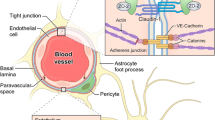Summary
Four drugs with potential anti-peritumoral brain edema activity were studied using the VX2 rabbit brain tumor model. Meclofenamate and indomethacin were tested in an attempt to confirm recent reports of anti-edema activity in non steroidal anti-inflammatory drugs (NSAID's). The “angiostatic” steroids 17 hydroxyprogesterone and epicortisol were tested because of their lack of glucocorticoid and mineralocorticoid effects and their structural similarity to glucocorticoids. The protein and water component of brain edema were indirectly quantitated. None of the test drugs demonstrated significant anti-edema activity. This work does not confirm reports that NSAID's have anti-edema activity and suggests that there may be no correlation between ‘angiostatic’ and anti-edema activity in certain steroid compounds.
Similar content being viewed by others
References
Weissman DE, Dufer D, Vogel V, Abeloff MD: Corticosteroid toxicity in neuro-oncology patients. J Neurooncol 5:125–128, 1987
Siegal T, Siegal T, Shohami E: The effect of dexamethasone and indomethacin on spinal cord prostanoids and edema in neoplastic epidural compression. Neurology 37(Suppl 1):311, 1987
Halpern J, Kishel SP, Park J, Tsukada Y, Johnson RJR, Ambrus JL: Radiation induced brain edema in primates studied with sequential brain CAT scanning and histopathology: Protective effect of sodium meclofenamate: a preliminary report. Res Comm Chem Pathol Pharmacol 45:463–470, 1984
Reichman HR, Farrell CL, Del Maestro RF: Effects of steroids and non steroid anti-inflammatory agents on vascular permeability in a rat glioma model. J Neurosurg 65:233–237, 1986
Ambrus JL, Halpern J, Baerwald H, Johnson RJR: Cyclooxygenase and lipo-oxygenase inhibitors may substitute for steroid treatment in brain edema. Lancet, 148–149, July 20, 1985
Crum R, Szabo S, Folkman J: A new class of steroids inhibits angiogenesis in the presence of heparin or a heparin fragment. Science 230:1375–1378, 1985
Carson BS, Anderson JH, Grossman SA, Hilton J, White CL, Colvin OM, Clark AW, Grochow LB, Kahn A, Murray KJ: Improved rabbit brain tumor model amenable to diagnostic radiographic procedures. Neurosurgery (2)5:603–608, 1982
Saria A, Lundberg JM: Evans Blue fluorescence: quantiative and morphological evaluation of vascular permeability in animal tissues. J Neurosci Methods 8:41–49, 1983
Chan PH, Fishman RA: The role of arachidonic acid in vasogenic brain edema. Fed Prod 43:210–213, 1984
Weissman D, Grossman S: A model for quantitation of peritumoral brain edema. J Neurosci Methods 23:207–210, 1988
Weissman D, Grossman S: Temporal development of peritumoral brain edema. Proceeding of AACR 27:71, 1986
Author information
Authors and Affiliations
Additional information
Indomethacin was supplied by Merck and Co., Rahway, N.J., Meclofenamate was supplied by Warner-Lambert, Morris Plains, N.J. 17 alpha hydroxyprogesterone and 11 alpha-epi compound F were supplied by Schering Corporation, Bloomfield, N.J.
Rights and permissions
About this article
Cite this article
Weissman, D.E., Stewart, C. Experimental drug therapy of peritumoral brain edema. J Neuro-Oncol 6, 339–342 (1988). https://doi.org/10.1007/BF00177429
Issue Date:
DOI: https://doi.org/10.1007/BF00177429




